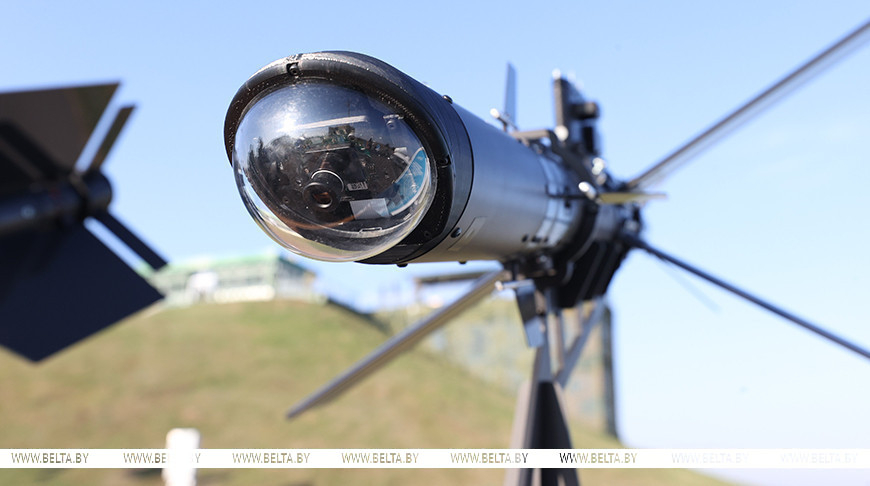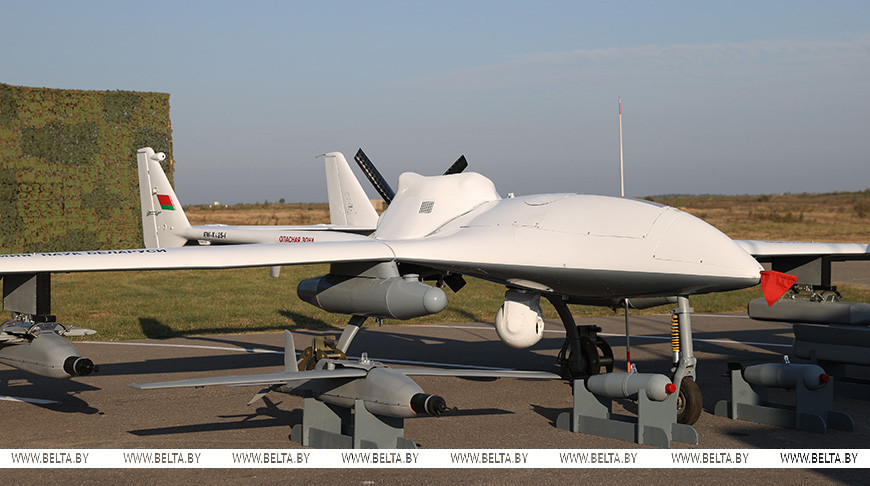
BARANOVICHI DISTRICT, 24 September (BelTA) – Belarus President Aleksandr Lukashenko went to the 230th combined arms military training area Obuz-Lesnovsky where he was made familiar with combat capabilities of promising Belarusian weapon systems, military and special hardware, BelTA has learned.
Over 30 military products of Belarusian make were presented by organizations run by the State Authority for Military Industry of Belarus and by defense industry companies. As many as 13 organizations run by the agency and six defense industry companies demonstrated their products.
The demonstration focused heavily on unmanned aerial complexes of Belarusian make.


According to the State Authority for Military Industry of Belarus, the strike drone complex Chekan-V and the small-range multifunctional drone complex Berkut-3 were developed and entered service in 2024. The strike drone complex Kvadro-1400 and a loitering munition drone complex had entered service before that. The State Authority for Military Industry of Belarus has organized their batch production.


The unmanned aerial complex Chekan V was developed by OAO 558 Aircraft Repair Plant and is designed to search, detect and engage stationary or slow-moving ground targets. The drones that make up the complex (from 7 to 10 drones) are single-use (“kamikaze”) drones with the operational range of up to 25 km.
The Chekan V complex has passed all kinds of trials and entered service with the Armed Forces of the Republic of Belarus in July 2024.
The strike complex implements elements of artificial intelligence for the sake of carrying out missions without human input. The drone carries a 2.3kg high-explosive fragmentation warhead and boasts a strike accuracy of less than 3 meters (competitors have a strike accuracy of 5 to 10 meters).

The short-range reconnaissance drone complex Berkut 3 was presented by OAO AGAT - Control Systems. The reconnaissance complex is designed for airborne optical and electronic reconnaissance in the visible and infrared ranges in day and night conditions. Berkut 3 entered service with the Armed Forces of the Republic of Belarus in March 2024.
The complex can use wire links and radio channels to connect to automated control systems of artillery units, which significantly reduces the time needed to deploy them in combat. The product is equipped with a radio system of Belarusian make that is resistant to radio-electronic jamming. The effective range of the Berkut 3 UAV is up to 50 kilometers. The flight time of the UAV is up to 3 hours. The deployment time is no more than 15 minutes.

The Kvadro-1400 and Barraging Tube UAVs are developed and mass-produced by OAO Design Bureau Display. They were accepted for service in September 2022 and are supplied to the Armed Forces of the Republic of Belarus.
The Kvadro-1400 UAV has a standard armament represented by two RPG-26 rocket launchers and is designed to engage lightly armored and unarmored vehicles and enemy personnel in field shelters. Maximum flight speed - 20 m/s, effective control distance - 5km, tactical range - 5km, total takeoff weight - 35kg.
The unmanned aerial vehicle (UAV) Barraging Tube has a standard armament in the form of one RPG-26 grenade launcher and is designed to hit lightly armored and unarmored vehicles and enemy personnel in field shelters. The UAV is fitted with a course video camera and a targeting one in addition to a thermal imager. Maximum flight speed - 20 m/s, effective control distance - 5km, tactical range - 2km, flight time - 15 minutes, takeoff weight - 12kg.

The next-gen products - the drone complex Mirotvorets and the drone complex Askalon - were presented by the limited liability company KB Unmanned Helicopters (UAVHELI). The State Authority for Military Industry of Belarus acted as the customer for this project.
Each drone complex features the same control and support solutions: a mobile control center, a launcher, and a transport and loading vehicle. The UAVs in use represent the only differences.
The unmanned aerial vehicle Mirotvorets [Peacemaker] is a strike drone designed to hit surface-to-air missile systems, MLRS and artillery systems at emplacement sites, reconnaissance and radio warfare systems of the enemy, columns of lightly armored and motorized vehicles, and enemy manpower. It is fitted with a turbojet engine capable of reaching speeds of up to 500kmph. The practical range depends on the altitude and can reach 180km. The flight time of the drone is 45 minutes. The high-explosive fragmentation warhead weighs 10kg.


Automatic flight control and automated flight control are the available options. As part of the former the drone flies according to a preloaded plan. As part of the latter the drone is controlled by an operator. Coordinates and intelligence data are used to guide the drone to the target.
The Askalon UAV is a small-size cruise missile designed to destroy SAMs, MLRS and artillery systems at emplacement sites, reconnaissance and radio warfare systems of the enemy, columns of lightly armored and motorized vehicles, enemy manpower and equipment. It is fitted with a turbojet engine, which is capable of reaching speeds of up to 700 kmph. The practical range is 310km, flight time is 60 minutes. Flight control is automatic (preloaded coordinates). The high-explosive fragmentation warhead weighs 10kg.
At present the unmanned aerial complexes Mirotvorets and Askalon (featuring Mirotvorets UAVs and small-size cruise missiles Askalon) are batch produced and are sold to defense, security, and law enforcement agencies of foreign countries. They are also in the process of being accepted for service with Belarus’ Armed Forces.
Another interesting R&D product presented by OOO KB Unmanned Helicopters was the helicopter-type reconnaissance and strike drone Hunter. It is designed to detect and engage: surface drones (anti-ship ones), low-speed air targets, armored vehicles, and enemy manpower.


The complex includes a ground control station, a ground support vehicle, a transportation platform and an unmanned helicopter.
In the post-Soviet space it is the only unmanned helicopter-type complex with the takeoff weight of more than 500kg. Only Northrop Grumman (USA) and Airbus Helicopters (France) offer unmanned helicopters with a comparable takeoff weight to the market.
Only the helicopter belonging to the complex was presented at the site in 2022. During today’s demonstration the company presented the main parts of the unmanned aerial complex: a ground control station, a ground support vehicle and a transportation platform belonging to the Hunter complex.
Apart from that, unlike the previous demonstration this one featured the second iteration of the reconnaissance and strike unmanned helicopter Hunter. It is a completely new product: new mechanics, new electronics, new transmission and a new carrier system.

The first domestic FPV drones were also presented. Thus, ZAO Unmanned Aerial Vehicles presented the aircraft-type FPV drone Akkord. The maximum range of the drone is 20km, cruising speed is 120 kmph, flight altitude varies from 50m to 1,500m, the payload weight is up to 2.5kg.
The key advantages of FPV drones include high speed, the first-person view of the flight for the operator, control accuracy as well as high quality of aerial photography (both photo and video).
OAO Design Bureau Display presented another promising R&D product at the site: a modification of the unmanned aerial complex Kvadro-M.
The complex is designed to hit lightly armored and unarmored targets, enemy manpower located in light field-type shelters in day and night conditions.
The UAV has a standard armament of 3 anti-tank aerial bombs PTAB-2.5. The UAV's release device is designed to allow the use of other free-falling munitions with the total mass of 7.5kg at most.
Unlike its predecessor Kvadro-1400 the new drone Kvadro-M boasts a 3-axis gyro-stabilized optical unit, which includes a visible spectrum camera with optical zoom, a thermal imaging camera and a rangefinder. This optical unit allows detecting and recognizing targets, aiming during bombing runs, and determining the target’s coordinates.

The digital radio channel the UAV uses allows operating up to 30 UAVs in an area simultaneously. This device does not require a specially prepared takeoff and landing site. It can be used in any terrain, including hard-to-reach areas.
Peculiarities of the Kvadro-M UAC include: tactical combat radius - up to 5km, UAV flight time - up to 25 minutes, maximum flight speed - 72kmph.
The next R&D product came from a factory located in Baranovichi. The company demonstrated the UAC Lovchy - a strike unmanned aerial complex featuring unmanned aerial vehicles with the combat range of up to 70km (UBAK-70). It can carry out special tasks involving searching, detection, hitting stationary, slow-moving ground objects day and night in various weather conditions at a distance of up to 70km.
The strike complex includes a ground control center and two UAVs. A total of eight unguided aerial weapons PTAB-2.5-1, which have been adapted for use with the UAVs, are used as the combat load.
The tactical range of the product reaches 70km, flight duration - up to 6.5 hours, cruising speed - 108 kmph, the maximum reconnaissance altitude reaches 3,000 meters.

During the show OAO Peleng presented experimental models of small caliber guided aerial weapons for use with UAVs of various types.
A guided aerial bomb can be used with multi-rotor UAVs. The altitude of its application varies from 300m to 1,000m, the mass of the warhead - up to 5kg, the range from the point of drop - up to one fourth of the drop altitude, the impact point accuracy - 1 m.
A guided gliding aerial bomb is used with aircraft-type UAVs, including UAVs of the vertical takeoff-landing type. The application altitude varies from 100 to 1000m, the mass of the warhead is up to 5kg, the range from the drop point is up to a quarter of the distance from the drop altitude, the impact point accuracy is 1 m.
The State Powder Metallurgy Research and Production Association in cooperation with the State Security Committee of the Republic of Belarus has developed high-explosive munitions weighing from 0.5 to 2kg and designed to hit enemy personnel using a helicopter-type drone (quadcopter) or using a kamikaze drone.
As a special feature of the product the munitions can be quickly assembled in the field to tweak performance parameters depending on the combat mission. A set of component parts allows assembling munition of different masses based on the basic products that weigh 0.5 and 1kg. It is possible to install fragmentation or thermobaric striking elements as well as their combinations. The specifically designed impact fuse is universal and is properly shielded. All munitions from the presented range are equipped with it.
Taking into account the experience of Russia’s special military operation in Ukraine trench-type UAV countermeasures were developed as soon as possible on the order of the Defense Ministry. All of them are going through trials successfully. Thus, the leading developer of radio warfare solutions OAO KB Radar presented:

the multicopter detector Zvonok - a pocket-sized device that can alert an individual about an incoming multicopter;
the radically updated radio electronic gun designed to combat multicopters Groza-R2. New frequency ranges for suppression were added. In addition to the suppression function the device can detect, identify, and provide the bearing for a multicopter;
the jammer of multicopter control and navigation signals Fumigator-N (portable) and Fumigator-V (transportable). These jammers can protect personnel and mobile objects from drones, including FPV ones. The jammers can be mixed and matched to combat various types of drones;
the portable multicopter signal detector and bearing finder Fluger that can be used together with the radio electronic gun Groza R2 or independently;
the multicopter signal detector and bearing finder Shapel can be used by a group of military personnel at a strong point, in a vehicle or an armored vehicle. It has been adopted for service by the order of the Belarusian defense minister.
the multicopter detection and location complex Dronoscope leverages the neural network technology to track the movement of multicopters on the map by decoding their radio signals. This product can be integrated into all radio warfare complexes - into radio warfare stations with UAVs R-349 (Egida) and R-936 (Aero); into the VHF jamming station R-934UM2.

Another new product presented by OAO KB Radar was the VHF radio monitoring and radio suppression complex R-936 (Aero). The complex is designed for:
search, detection, direction finding to UAVs by intercepting data transmission channel signals;
search, detection, direction finding to the UAV ground control unit by intercepting control channel signals;
determination of the UAV location zone (barraging) and the location zone of the ground control station using radio direction finders by coupling two Groza-S stations;
recognition of control and data transmission protocols, identification of DJI family UAVs, determination of their current coordinates and coordinates of the “home” (take-off) point;
friend-or-foe recognition of DJI family UAVs;
radio suppression of UAV control channels;
radio suppression of data transmission channels used by the ground control station;
radio suppression of onboard equipment of the satellite navigation systems GPS, GLONASS, Galileo, BeiDou (all GNSS systems);
deception jamming of the onboard equipment of GNSS satellite navigation systems;
UAV detection using a two-channel television and thermal imaging module based on information about the direction to the UAV from the station direction finder, UAV tracking.
Apart from that, the demonstration featured the electronic warfare station Groza S, which has earned excellent reputation and is designed to provide detection, direction finding, location and electronic countermeasures against UAVs (mass-produced quadcopters, homemade and military tactical UAVs).

As part of the practical demonstration the State Authority for Military Industry of Belarus demonstrated promising prototypes of weapons, military, and special-purpose hardware, including those based on new physics principles.
The practical demonstration began with bombing runs that featured either drones dropping high-explosive munitions weighing from 500g to 2kg or FPV drones delivering the munitions to the target. Practical demonstration of Belarusian unmanned aerial complexes Kvadro-M, Chekan-V, Mirotvorets, and Lovchy followed. All of them accomplished their missions in full compliance with their tactical and technical parameters.
During the demonstration of how counterdrone measures are employed during combat in practice the president had a chance to see the products Zvonok and Fumigator in action. They allow military personnel to detect and prevent attacks of enemy drones against an assault team or a medical vehicle in a timely manner. Spectators could also see how the radio warfare station R-936 (Aero) suppressed the control channel of an aircraft-type reconnaissance drone.
The practical demonstration continued with a tactical episode meant to show how a breakthrough across the state border can be repulsed. In order to set up an ambush along the possible axis of advance of a sabotage and reconnaissance force a squad was deployed in armored personnel carriers BTR V2 fitted with remotely controlled combat modules Adunok BM30.2. The main armament of the module is the 30mm automatic cannon 2A42 paired with the PKT 7.62mm machine gun. Unlike the previous version Adunok BM30 the new module is also fitted with the anti-armor missile system Konkurs-RB with guide rails for two antitank guided missiles of 9M113, 9M113M varieties. The module is also fitted with the smoke grenade launcher 902V.


The sabotage and reconnaissance force was hit by the fire of the armored personnel carriers BTR V2 and the Belarusian grenade launcher Sapfir, which had been developed by the Belspetsvneshtechnika enterprise. The complex has two operation modes: contact and trajectory (the payload can be detonated at a specified range). It can also fire clusters of up to four munitions for higher density of fire.
The practical demonstration ended with practical work of a battery of multiple-launch rocket systems BM-21-B Belgrad-2 developed by OAO 2566 Radioelectronic Armament Repair Plant (OAO 2566 REARP), with fire adjustment provided by the unmanned aerial complex Berkut.


Representatives of the State Authority for Military Industry of Belarus stated that the demonstration once again proved that Belarusian weapon developers keep up with the times and are capable of meeting modern challenges and threats to military security by helping accomplish combat missions in a modern firefight.













